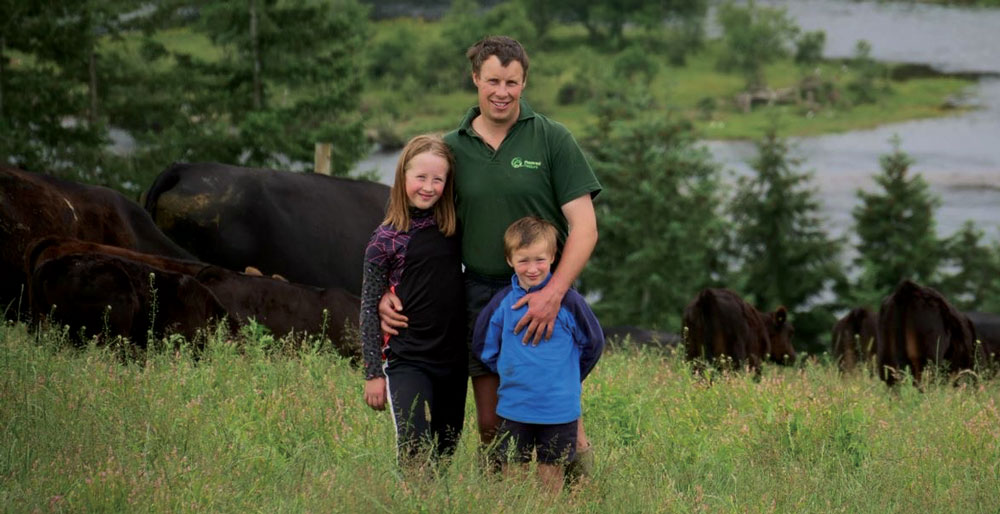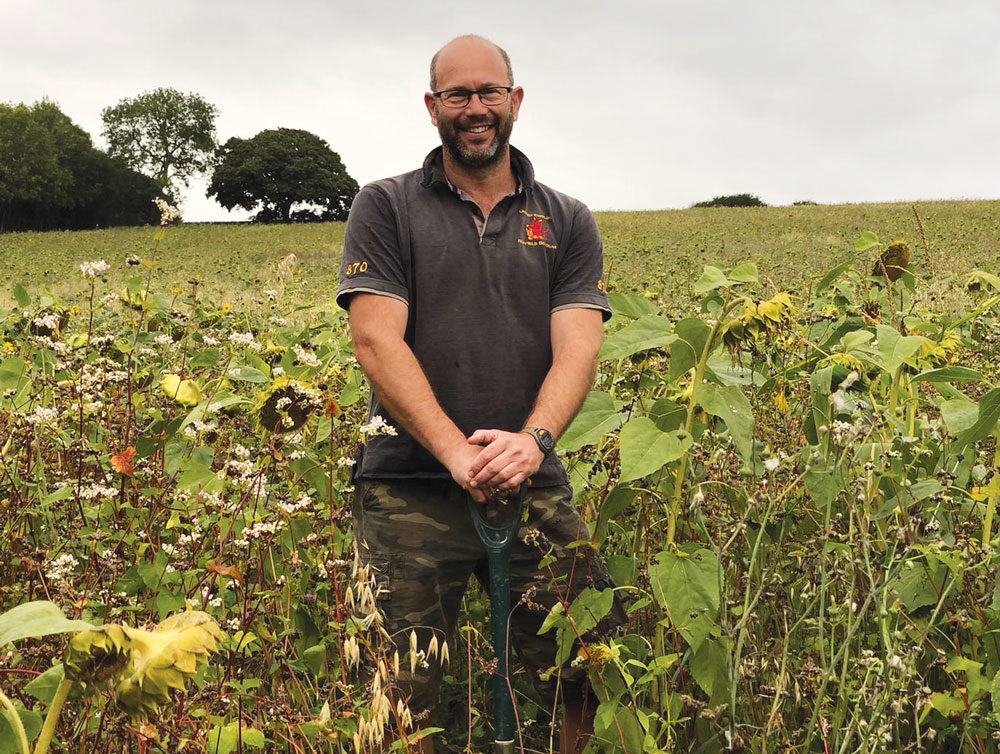Pictured Above: NO-TILL WORKS. Jake Freestone says switching to no-till practices has provided “huge soil health benefits” on his 4,000-acre farm. “It’s enabled us to grow bigger and better cover crops that we can drill straight into. That is reducing our costs and also improving soil structure and organic matter,” he says.
(Editor’s note: This article is being shared from Direct Driller, a magazine covering no-till and regenerative ag practices in the U.K.)
Direct Driller magazine has been hosting a Soil Farmer of the Year competition for the last 5 years. The goal is to find, promote and champion farmers putting soil health at the center of their farm business management.
This year the competition has been slightly challenging to run due to the COVID pandemic and the inability to conduct judging in person. The magazine’s finalists created videos detailing their individual farm journey to sustainable soil management, and they endured a virtual grilling from the judging panel to decide the results.
The top accolade this year was awarded jointly to two farmers — Jake Freestone from Overbury Farms, and Alex Brewster from Rotmell Farm. Both farmers have been doing amazing things around soil management in very different locations and settings. The third-place farmer this year was John Martin from Dorset, who has been working on soil management for over 20 years.
Here are some details about each of the winners as we celebrate soil health with farmers across the Atlantic.
Jake Freestone, Gloucestershire, U.K.
Jake Freestone has been managing Overbury Farms since 2003. The farm sits within the wider estate on the Gloucestershire/Worcestershire border and is a mixed farm with 4,000 acres of farmland, both permanent pasture and arable cropping, some land let out for vegetable production and a flock of 1,000 ewes.
The farm’s soils are incredibly varied, from Cotswold Brash to an Evesham Clay series, and the farm has a diverse and wide rotation to help deal with the soil variance.
The rotation includes wheat, spring barley, oilseed rape, peas, beans, linseed and quinoa. Freestone started focusing on soil health and looking at adapting management following his Nuffield scholarship, working on a reduction in cultivation, improving organic matter and diversifying the rotation.
“Switching to no-till has given us huge soil health benefits on the farm,” Freestone explains. “It’s enabled us to grow bigger and better cover crops that we can drill straight into. That is reducing our costs and also improving soil structure and organic matter.
“Especially on our stonier soils, we aren’t having to move the stones as we were previously when we were cultivating conventionally. And the soil structure is also protected and helping with water infiltration — which is key on this farm as we supply the nearby villages with drinking water.”
Other benefits come from a reduction in weed burdens and the ability for the farm to support enhanced biodiversity, “so no-till is really a crucial part of the jigsaw,” he adds.
Freestone is seeing the benefits from these changes, both in terms of improved soil health and in economics. Benefits include the soil being easier to work with, which has led to a faster work rate and a reduction in diesel costs.
Water infiltration is enhanced and there is a large reduction in runoff and erosion, with any runoff that does happen being clean water. Freestone is seeing more insect life and reduced pest issues alongside no insecticide use and has managed to reduce both nitrogen and phosphate fertilizer rates.
The journey hasn’t reached an end though and there are more innovations and experiments planned, including the use of a fertilizer tank on the front of the drill to apply biological inputs at the time of drilling. Other experiments include companion cropping, looking to optimize integrated pest management and a continuation of the reduction in nitrogen fertilizer usage across the farm.
“Ultimately we are trying to use all the tools that we have to improve soil organic matter, water infiltration and wider water management, soil structure and soil biology to achieve the long-term goal of improving our resilience both for our crops, our business and our soil,” he says.
Alex Brewster, Perthshire, U.K.
Alex Brewster operates Rotmell Farm in Perthshire. The farm is an upland beef and sheep operation with 200 breeding cows and a flock of 700 sheep. The farm occupies just under 2,500 acres, with about 300 acres of that being improved pasture based on a sandy clay loam soil. The rest is rough hill ground with typical upland soils.
Brewster has been working on building the biological capacity within the soil through the use of rotational and mob grazing systems. Starting out with a transition to a rotational grazing system, he has adapted it into a hybrid mob system with a focus on improving the diversity of plants within the pasture.
Other goals are to improve both soil organic matter and pH through the use of animals, and to build a deeper root depth and mass to allow the plants to access slightly warmer soils and moisture found deeper in the soil when temperatures drop in the winter.

MOB MENTALITY. Alex Brewster operates Rotmell Farm in Perthshire — an upland beef and sheep farm with 200 breeding cows and a flock of 700 sheep occupying about 2,500 acres. He’s been working on building the biological capacity within the soil through using rotational and mob grazing systems.
Brewster says soil temperature is the biggest limiting factor to grassland production, so by allowing the plants to root deeper and providing a cover on the soil through trampling some of the grass down, the soil can be protected from the weather and stay warmer for longer. This also transfers some of the carbon to the lower soil layers.
Brewster is also focusing on improving the hill ground, noting there is a huge capacity to improve the potential of the quality of some of his upland areas and the nutrition that ground provides.
“We’re working on subdividing bigger blocks of land into hill paddocks. We’re also working on animal impact, building fairly tall grass covers, and then eating off 50% of the grass and trying to trample the rest to recycle the nutrients of the remaining 50% back into the topsoil.”
The increase in biological diversity is key to the whole system. “By increasing the diversity of plants within the grass leys, there is an increase in leaf sizes, grass heights and densities which is more efficient at capturing sunlight — which can then be turned into red meat. We want to create a system that optimizes the feed value of this plant.”
Brewster says he’s seen a lot of change on the farm, especially over the last few years. Rooting depth has increased dramatically and the amount of friable soil is increasing to depth. He’s also seeing improvement in water retention and improving earthworm numbers.
This is all leading to an increasing resilience to extreme weather patterns and a productive benefit arising with the grass remaining greener for longer. And the farm is keeping stock out for longer than in previous years, while at the same time carrying a higher number of stock.
This rebalancing is also being seen in the forage, Brewster says, both in terms of improved grass yields but also mineralization from forage analysis. Brewster does regular forage analysis and then targets the minerals for the cattle to address any imbalances found in the forage.
“We’ve doubled cow numbers in the last 5 years but we are actually using less bagged mineral than we were 5 years ago,” he notes.
Brewster is seeing the benefits both in terms of animal performance but also in the pasture, with a larger rooting depth and root mass within the soil.
There are more plans in the future to continue to evolve and hone the system to achieve Brewster’s aim of managing a beef and sheep farm which is totally carbon positive, promoting the benefits of animal impacts in land management and the relationship between rumen microbiology and soil microbiology.
“The future of farming is this absolute linkage within the total nutrient system. It’s total nutrient of soils, total nutrient of pasture, and of red meat produced from these pastures and how these red meats then feed back into the food chain,” Brewster says. “It’s a really strong story that’s positive and beneficial for the future understanding of what food production really should be.”
John Martin, Dorset, U.K.
John Martin farms 300 acres in Dorset on an all-arable rotation with two-thirds of the farm in spring cropping.
The farm was a dairy farm until 2000, and since then the overarching aim of the management has been to keep the soil status in good health.
Martin’s farm is situated in an area with a high degree of designations on it, being within a Class 1 Soil Protection Zone, an NVZ (nitrate vulnerable zone) and the Poole Harbor Catchment, meaning that there has been a large focus on efficient nutrient use, especially on nitrogen.
Martin’s focus on his soils is linked to his overarching aim for the farm which is to develop a more sustainable way of farming with consistent yields.
He is involved in a range of applied research projects on the farm. One involves the ASSIST project, planting flowering strips through the middle of fields to aid in beneficial insect populations. Another is looking at reducing leaching from peas through using cover crops with Wessex Water.
A key strategy employed on the farm to boost soil health and help capture nutrients has been the use of cover crops. All of the land that is in spring crops has a cover crop before it, and Martin has been experimenting with increasing the diversity of the mix. The mix now includes sunflowers, buckwheat, phacelia, linseed and various clovers to ensure a diverse diet to boost soil biology.
“It’s like taking a party of people to a fish-and-chip shop. Some will want fish, some sausage and some pie and chips,” he says. “All of the soil bugs bring something to the party and are all important, so we need to provide a diverse food supply for them so they can do their jobs.”
Martin is farming on chalk soils and enjoys the challenges this soil type can bring. He first started looking at soils in the 1980s, digging his first soil pit in 1985. This prompted a move towards bigger, low-ground-pressure tires and focusing on axle weights of machinery to minimize compaction.
There is always a spade in the tractor allowing Martin to assess the structure of the soil at two key periods in the year; in winter when the soils are wet, to assess how the drainage is doing, and then after cultivation to see whether the machine has achieved its goal.
The chalk soils mean that Martin is keen to build resilience in his soils to aid water retention. A key strategy is focusing on returning organic matter to the soil to build humus. All of the crop residues are chopped and returned to the fields, and 75% of the farm is cover cropped to ensure that there is something growing all year round.
When Martin started his transition to enhanced soil management he took some baseline soil samples and saw the work that needed to be done.
“We tested fields for organic matter and they weren’t bad, but we wanted to increase it another 1-1.5%,” he says. “If we can get hold of that then we’ve got more resilient soils to do spring cropping. We can tell that we are moving in the right direction as the soils are much springier. That elasticity is coming from the humus and the soils are developing the resilience to carry us through.”








Post a comment
Report Abusive Comment